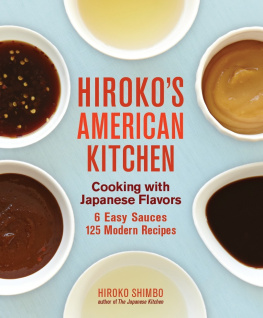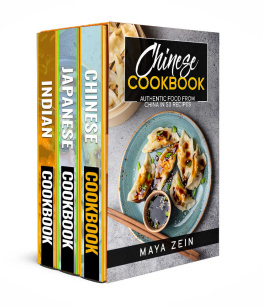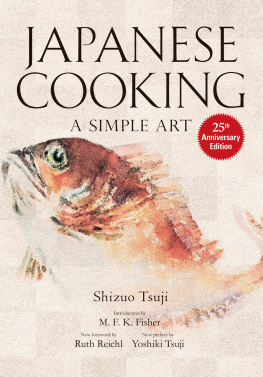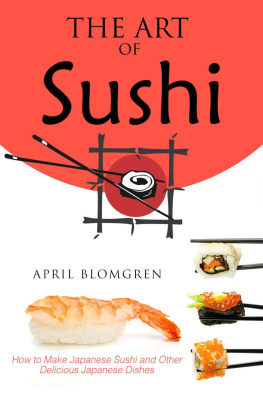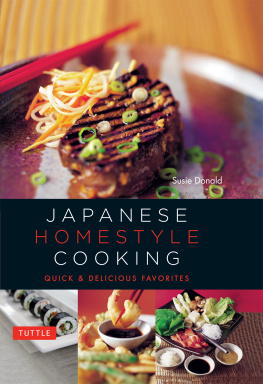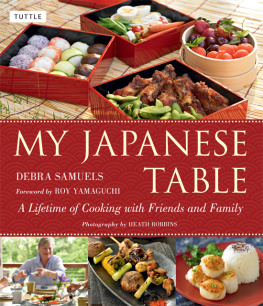Acknowledgments
In the past years I have been blessed to work with many highly qualified and generous people, companies, government organizations, and professional cooking schools promoting Japanese cuisine in the United States. Each experience has challenged me and helped me grow. My first book, The Japanese Kitchen , is the foundation I have built on as a devoted explorer, practitioner, and promoter of classical Japanese cuisine . My heartfelt gratitude goes to all whom I contacted and worked with in the past years to develop the expertise that is the cornerstone of this book.
While writing this book the voice of my mother, Tokuko Shimbo, and what she taught me about cooking and life in general were always on my mind, even though she is far away in Tokyo. The seed for what I have grown into, where I am now , and what I am doing was planted by her mother, Setsu Okada. She was a great cook who 90 years ago in rural Japan was already deeply immersed in mastering many aspects of international cuisine. She was decades ahead of her time. Indeed I feel the influence of all of my family members and their ancestors on what I have written here.
For the development of recipes in this book I was fortunate to have the devoted assistance of a group of talented, young volunteers who, as trained cooking professionals, are becoming competent and confident chefs and are also my dear friends. Special thanks to Christina Wang, Georgia Wand Freedman, Anna Yeung, and Jennifer Batts.
I am indebted to photographer Frances Janisch, food stylist Michael Pederson, and Executive Art Director Tim Lynch, of Andrews McMeel Publishing, LLC, for the creative, high quality, and very useful photographs in the book.
Jean Lucas, my editor, patiently heard and respected my voice in the work during the editing and jacket design process. It was Dorothy Kalins who kindly introduced me to Andrews McMeel publisher Kirsty Melville, who made the book a reality. A special thanks also to my agent, Janis Donnaud, who always stands by me.
Finally, this book is a product of my marriage to Buzz. As he did for my previous two books, Buzz played the roles of in-house editor and critic of early recipe developments, which by necessity have to be repeated several times to get them right. Buzzs love and care about food and his experience of living in Japan for fourteen years enable him to be the best person for these roles. Big love and thank you. We look forward to watching this third book-child grow by opening a new and delicious Japanese world of flavors for you.
Hiroko Shimbo
is a chef-consultant for restaurants and food companies, a trained sushi chef, an award-winning author, a media performer, and a chef-instructor. She is also a frequent guest chef at the Worlds of Flavors Conference at the Culinary Institute of America. Hiroko appears in the media and online through her own Web site, blog, and Twitter account (@hirokoshimbo), as well as on such services as About.com. She is a member of the Women Chefs and Restaurateurs and the Authors Guild, and is a sushi adviser for the Blue Ocean Institute.
CHAPTER 1
KELP
STOCK
In Japan, kelp stock is the most basic vegetarian stock. When this stock is infused with dried skipjack tuna flakes, katsuobushi , it becomes another main stock, dashi. Simple kelp stock is used to prepare vegetarian or delicately flavored dishes in which the pleasant but smoky fish flavor of dashi is too strong. When kelp stock is used as a base for other recipes, it is then usually flavored with a combination of key Japanese seasonings such as sea salt, shoyu, miso, mirin, sake, sugar, and rice vinegar.
Today, chefs working in American kitchens have begun to use kelp stock in their non-Japanese preparations. Its clean and lean appeal and produces light, new flavor profiles in an array of different types of dishes.
In this chapter, I will show you how easily you can make this simple, flavorful stock, which you can then use in many recipes. These recipes can become delicious, healthful, and everyday additions to your kitchen repertoire.
First, some tips on sourcing, purchasing, and proper storage of kelp. You can find kelp at nearly every Japanese or Asian market, as well as at some of . Kelp for stock should have the following characteristics:
- The kelp leaf is as thick as three or four sheets of copy paper.
- It is thoroughly dried. The leaves in the plastic package should feel hard and should not be flexible.
- It is deep black-green in color with a touch of glossiness.
- It has no brown blemishes.
- It is covered evenly with a very faint layer of mannite, a natural white powder that is a carbohydrate and source of sweetness.
After opening the package, close it tightly with a rubber band and store it in a cool, dry cabinet. It will keep stored like this for about a year.
If finding kelp is a problem, you can substitute low-sodium vegetable stock for the kelp stock, which will still give you the chance to learn how to prepare and flavor the dishes in this chapter in the Japanese style.
Kelp Stock: Traditional Easy Method
There are two ways to produce kelp stock: by this Traditional Easy Method and by a newly developed method often used by . This first method can fit easily into a busy home cooks lifestyle. Please note that you must soak the kelp overnight.
I frequently double or triple stock recipes and refrigerate or freeze unused stock in small plastic containers. To defrost frozen stock, I place it in a small pan with a tight-fitting lid and cook over medium heat. Defrosting 2 cups of frozen stock this way takes about 5 minutes.
MAKES 8 CUPS
8 cups
1 ounce kelp (two 4 by 7-inch sheets )
Pour the water into a large bowl. Wipe the kelp with a moist, clean kitchen towel to remove any sand or impurities. Do not wipe off the white mannite powder. Add the kelp to the bowl (you may need to break the kelp into pieces to fit into the bowl). Cover the bowl with plastic wrap and refrigerate overnight.
Remove the kelp from the water and reserve for a . On the ends of the swollen kelp you will see some oozing of a slimy liquid. This is a healthful, dietary fiber and a portion of it has already been dissolved in the stock. If a greenish slimy substance is leaking out into the water and is clouding the stock, it is a sign that you are using poor-quality kelp, as stock prepared from good-quality kelp will be clear in appearance. If necessary, strain the stock through a sieve lined with a moist, sturdy paper towel to remove any impurities. The stock is then ready to be used, or it can be refrigerated for 2 to 3 days or frozen for up to 2 months.
Umami: Savory Flavor
Umami is a Japanese word that describes the fifth taste after the basic four of sweet, salty, sour, and bitter. It is best described as a savory element. Umami, whose major chemical component is glutamate, was isolated and identified by Dr. Kikunae Ikeda in 908 at the Imperial Uni versity of Tokyo. Glutamate is naturally present in many foods, but the greatest amount is found in kelp. In fact, kelp has eight times the amount of glutamate found in tomatoes and other glutamate-rich foods.
There are two other chemicals that form umami: inosinate and guanylate. Both compo nents were identified by Japanese scientists Dr. Shintaro Kodama and Dr. Akira Kuninaka. Inosinate is found in meat and fish, while guanylate is found in dried mushrooms such as shiitake . The use of these umami - rich ingredients kelp, dried fish flakes, and shiitake mushrooms lends savory flavor and richness to Japanese dishes without the use of oil. It is interesting to note that mothers milk is also high in umami, and this is thought to satisfy the appetite of nursing infants. So if you were breast-fed, you had an early appreciation of umami, and this no doubt gave you a primal and innate understanding of what is tasty and delicious.

